MARKET OVERVIEW
The global lithium chemicals market is a specialty segment of the broader chemical industry, characterized by the production, processing, and sale of chemical products derived from lithium. Compounds based on lithium will continue to be important materials in a variety of industrial applications with particular relevance in manufacturing applications where performance, energy storage, and technological advancement demand high-purity chemical feedstocks. As compared to more commodity-type segments of the chemical marketplace, this market is not across several chemicals, but is specifically focused on lithium by itself in its various states of chemistry, including lithium carbonate, lithium hydroxide, lithium chloride, and a variety of specialty chemicals designed to meet evolving industrial needs.
As the sectors shift towards advanced material sciences, lithium-based chemicals demand will establish new paradigms for supply chains, regulation, and manufacturing standards. These chemicals will not only assist in the development of energy solutions but also influence industries where precision chemistry determines product outcomes. Batteries, ceramics, lubricants, polymers, and pharmaceuticals will continue to be some of the industries that require uniform and predictable sources of lithium chemicals. But beyond these recorded applications, future needs will induce innovations that will thrust the uses of lithium compounds into new frontiers of technology.
The global lithium chemicals market will be marked by specificity in the manufacturing process. Extraction technology, refining technology, and chemical conversion will mark it. These processes will distinguish this market from common mining or base chemical businesses because the final products need to have tight control over purity, molecular structure, and chemical performance characteristics. Manufacturers in this business will align their products to high-precision requirements, enabling their clients to achieve higher performance in commodities that normally rely on marginal chemical consistencies.
Since the regulations governing production of resources and environmental measures will undergo a change, the global lithium chemicals market will remain abreast of developments in production and waste technology. Processes will move towards sustainability, not just to meet legislation but to appease growing expectations of downstream consumers and industries that are concerned about environmental stewardship. This shift will trigger innovation within the marketplace, with emphasis on reducing environmental impacts while maintaining high-quality outputs necessary for uses that are vital to society.
The complexity of the supply environment will shape the market's form over the coming years. Geopolitics, trade patterns, and local resource allocations will control availability and price regimes. This market will be neither independent nor isolated; instead, it will be dynamically interdependent with markets that use lithium chemicals to drive their own technological ambitions. Producers, refiners, and users will become increasingly involved in relationships with each other as supply becomes increasingly more of a strategic concern than an unproblematic procurement issue.
Besides, technological advancements in material sciences will push the boundaries of what can be achieved with lithium chemicals. R&D efforts seek to introduce new chemical compounds and applications based on present technology or even develop new industries altogether. The market's future will not rest on perpetuating existing supply chains but also on its ability to measure and keep up with these shifting demands.
Lastly, the global lithium chemicals market will continue to be a pillar in the niche chemicals industry, serving across many different industries that will continue to be dependent on its products for innovation, efficiency, and technology innovation.
Global lithium chemicals market is estimated to reach $128,967.41 Million by 2032; growing at a CAGR of 19.4% from 2025 to 2032.
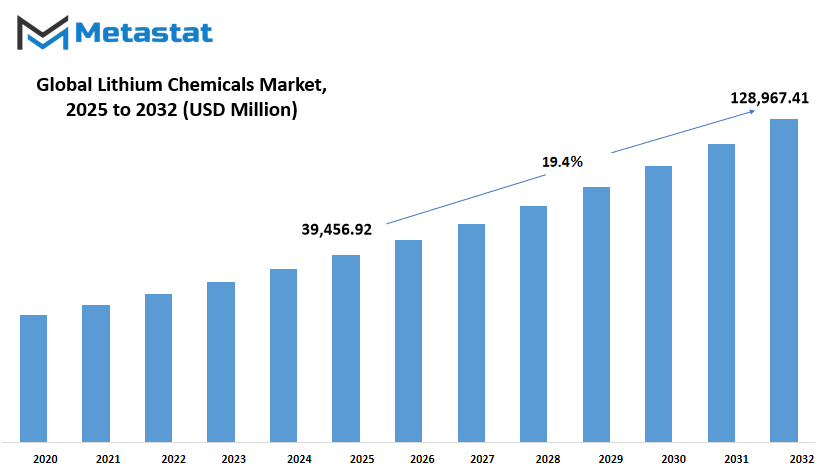
GROWTH FACTORS
The global lithium chemicals market will play a major role in shaping the future of industries across the world. As technology keeps moving forward, the demand for these chemicals will continue to grow steadily. They are widely used in batteries, especially those found in electric vehicles, mobile devices, and energy storage systems. The future of transportation and energy depends heavily on how efficiently and sustainably these chemicals are produced and utilized. As more countries push toward clean energy and electric mobility, the importance of Global Lithium Chemicals will only become stronger. These chemicals will not only power vehicles but also support efforts to reduce carbon emissions, making cities cleaner and helping to combat climate change.
One of the key driving factors behind the global lithium chemicals market growth is the rising demand for electric vehicles. Governments and companies around the world are making bigger commitments to cut down on fossil fuel use. This shift is creating a strong need for high-performance lithium batteries, and in turn, for the chemicals used to make them. Another important factor is the rapid development of renewable energy projects. Solar and wind energy require efficient storage solutions, and lithium-based batteries provide just that. The focus on storing clean energy safely and effectively is pushing the need for these chemicals even further.
However, certain challenges might slow down this growth. Environmental concerns related to lithium extraction could become a serious obstacle. Mining processes can harm ecosystems, and there is growing pressure on companies to adopt more sustainable methods. Additionally, fluctuations in the prices of raw materials might also hamper the market. These shifts can make production costs unpredictable, affecting both manufacturers and consumers. Addressing these issues will require ongoing innovation and responsible practices from those involved in the supply chain.
Looking ahead, recycling technologies would provide lucrative opportunities for the global lithium chemicals market in the coming years. As the number of used batteries rises, recovering lithium from them will become both necessary and profitable. This approach will not only reduce environmental impact but also lessen the need for new mining. Companies that focus on developing efficient recycling methods will likely see strong growth. Moreover, advancements in battery technology could lead to new applications for Global Lithium Chemicals, expanding their use beyond current expectations. This ongoing progress promises a future where these chemicals remain at the center of technological advancements, helping to power a world that is cleaner, smarter, and more connected.
MARKET SEGMENTATION
By Product Type
The future of global lithium chemicals market looks promising as demand continues to rise due to technological advancements and the growing need for sustainable energy solutions. Lithium, being a crucial element in battery production, has attracted attention from industries across the world. With electric vehicle becoming more common and renewable energy storage systems expanding, the role of Global Lithium Chemicals is becoming more important than ever before. This shift is not only creating new opportunities but also shaping the future of how industries and consumers will use energy.
The global lithium chemicals market are typically categorized by different by-products, each serving unique functions in various sectors. Lithium Carbonate, for example, is widely used in batteries, especially for electric cars. It is also essential in the production of ceramics and glass, which further strengthens its value across multiple industries. Lithium Hydroxide is gaining popularity for its efficiency in high-nickel batteries, which are seen as the future of electric vehicle technology due to their improved energy density and longer lifespan. This particular by-product will likely experience increased demand as the push for better battery performance continues.
Lithium Chloride plays a significant role in industrial processes, including air conditioning and aluminum production. While it may not be as widely recognized as Lithium Carbonate or Lithium Hydroxide, its presence is still vital for manufacturing and other industrial uses. On the other hand, Lithium Metal is key in creating high-performance batteries, particularly for aerospace and defense applications, where lightweight and high-energy solutions are necessary. The use of Lithium Metal is expected to grow as technology companies search for even more efficient ways to store and use energy.
There are also other forms within the global lithium chemicals market that serve specific purposes in niche applications. These may include compounds used in pharmaceuticals or specialized industrial settings. As technology advances, it is likely that new uses for these lesser-known by-products will emerge, adding further value to the industry.
Looking ahead, the global lithium chemicals market will remain a driving force in energy transformation. Governments and companies around the world are investing heavily in research to develop better energy solutions, and lithium will continue to be a key material in this progress. The focus will be on creating products that are not only more efficient but also environmentally friendly, ensuring that future generations benefit from cleaner energy solutions. This growing demand and innovation will shape how Global Lithium Chemicals evolve, making it a cornerstone of future industrial and technological growth.
By Application
The future of the global lithium chemicals market is expected to show steady growth as more industries begin to recognize the value and potential of lithium-based products. Among the many uses, the application of lithium chemicals in batteries stands out as the most significant. With the continuous shift toward electric vehicles and renewable energy storage, batteries will remain a key driver for the demand of lithium chemicals. The push from governments and corporations to reduce carbon emissions is shaping a future where battery technology will play a larger role, and lithium will be at the center of this transformation. It is likely that advancements in battery efficiency and the growing need for longer-lasting energy storage solutions will further support the growth of this market.
Another important area where the global lithium chemicals market will continue to have a presence is in glass and ceramics. These materials rely on lithium to improve strength, durability, and heat resistance. As the demand for advanced construction materials rises, manufacturers will likely keep turning to lithium-based additives to enhance their products. This is especially true as industries look for solutions that meet both safety standards and environmental concerns. In the future, buildings and infrastructure will require materials that can endure more extreme conditions, and lithium will remain a valuable ingredient in meeting these demands.
Lubricants and greases also make use of lithium chemicals, providing stability and performance benefits across a wide range of mechanical systems. As machinery becomes more sophisticated and industries seek longer equipment lifespans with less maintenance, the demand for reliable lubrication will grow. Lithium-based greases are already recognized for their high performance, and this reputation will help maintain steady demand within this sector.
Air treatment is another application where the global lithium chemicals market plays a role. Lithium can be used to absorb carbon dioxide and moisture, making it useful in air purification systems. As concerns about air quality continue to rise globally, the importance of technologies that improve indoor and outdoor air will likely increase. This creates opportunities for lithium products to be part of future air treatment solutions, especially in densely populated or industrial areas where clean air is becoming more of a challenge.
There are other smaller uses for lithium chemicals that may also see growth, though perhaps at a slower pace compared to batteries or industrial applications. As technology develops and industries evolve, lithium’s versatility will continue to open new possibilities. Overall, the future looks promising for the global lithium chemicals market as it adapts and expands into these key applications.
By End-Use Industry
The future of the global lithium chemicals market looks very promising as demand for lithium-based products continues to rise steadily across various industries. Lithium is now seen as one of the most important materials for the future, largely because of its role in shaping technologies that will define the coming decades. These chemicals are used in the production of batteries, which are vital for electric vehicles, smartphones, laptops, and other devices that people rely on every day. As societies move toward cleaner energy and technology that reduces harm to the environment, the need for lithium chemicals is expected to grow at a steady pace.
One of the most significant industries driving this demand is the automotive sector. Electric vehicles, often known simply as EVs, depend heavily on lithium-ion batteries because of their long life and efficiency. Many governments and manufacturers around the world are now working on phasing out traditional fuel-powered vehicles in favor of cleaner, electric alternatives. This shift will not happen overnight, but the future will likely see roads dominated by EVs, all of which will need lithium-based batteries. As a result, the global lithium chemicals market will likely experience consistent growth for years to come.
Electronics is another area where these chemicals play a key role. Devices like mobile phones, laptops, and tablets rely on lithium to function properly. As technology becomes more advanced and people expect more from their devices in terms of battery life and performance, the demand for reliable lithium chemicals will continue to rise. This trend shows no signs of slowing down, as consumers keep upgrading their electronics more frequently than ever before.
The aerospace industry also contributes to the growing demand. Aircraft manufacturers are exploring battery-powered options to reduce carbon emissions, and lithium is central to these plans. Though still in the early stages, future developments could bring aircraft that use lithium-based batteries into mainstream use, further increasing the need for global lithium chemicals market.
Energy and utilities will also benefit from advances in lithium technology. As more regions invest in renewable energy sources like solar and wind, efficient energy storage becomes more important. Lithium-ion batteries allow for energy to be stored and used when needed, making power grids more reliable and flexible.
Pharmaceuticals and other industries are also exploring the unique properties of lithium. While their usage is not as widespread as in the sectors mentioned, the potential for future applications remains high. All signs point to a future where the global lithium chemicals market will continue to play a crucial role across multiple industries.
|
Forecast Period |
2025-2032 |
|
Market Size in 2025 |
$39,456.92 million |
|
Market Size by 2032 |
$128,967.41 Million |
|
Growth Rate from 2025 to 2032 |
19.4% |
|
Base Year |
2024 |
|
Regions Covered |
North America, Europe, Asia-Pacific, South America, Middle East & Africa |
REGIONAL ANALYSIS
The global lithium chemicals market is expanding steadily across various regions, with each contributing differently to its overall growth. As the demand for energy solutions increases, especially for electric vehicles and renewable energy storage, the role of lithium chemicals is expected to become even more significant. North America is one of the leading regions, with the United States, Canada, and Mexico being the key players. These countries have been focusing on strengthening their supply chains and building partnerships that will ensure they stay competitive in this fast-growing sector. Companies here are looking ahead, working on ways to secure lithium resources and improve their processing technologies to meet future demand.
Europe is another important market, with the UK, Germany, France, Italy, and other nations showing increased interest in lithium chemicals. This is mainly because of the region’s push towards clean energy and the transition to electric vehicles. Governments are setting ambitious targets for reducing carbon emissions, which naturally drives the need for more advanced battery materials. In response, businesses are investing in local production facilities and forming alliances with raw material suppliers to reduce dependence on imports.
Asia-Pacific is perhaps the most dynamic region, especially with countries like China, Japan, South Korea, and India making strong moves in this field. China leads the way, not just in terms of manufacturing but also in research and innovation connected to lithium chemicals. Japan and South Korea continue to advance battery technologies, while India is gradually building its infrastructure to support the shift to cleaner energy. These efforts suggest that Asia-Pacific will play a crucial role in shaping the future of the global lithium chemicals market.
In South America, nations such as Brazil and Argentina are becoming more involved, recognizing the potential of their natural resources. These countries are working to enhance their mining operations and create value by participating more in the processing stages rather than merely exporting raw materials. This forward-thinking approach will help them capture more benefits from the growing demand.
The Middle East and Africa are also starting to realize the opportunities within this industry. Countries like South Africa, Egypt, and those within the GCC are exploring how they can contribute, either through resource development or partnerships with established industry leaders. As the world looks for cleaner energy solutions, these regions could find new opportunities to diversify their economies through lithium chemicals.
Looking ahead, it is clear that Global Lithium Chemicals will continue to influence energy markets and technological progress across all these regions.
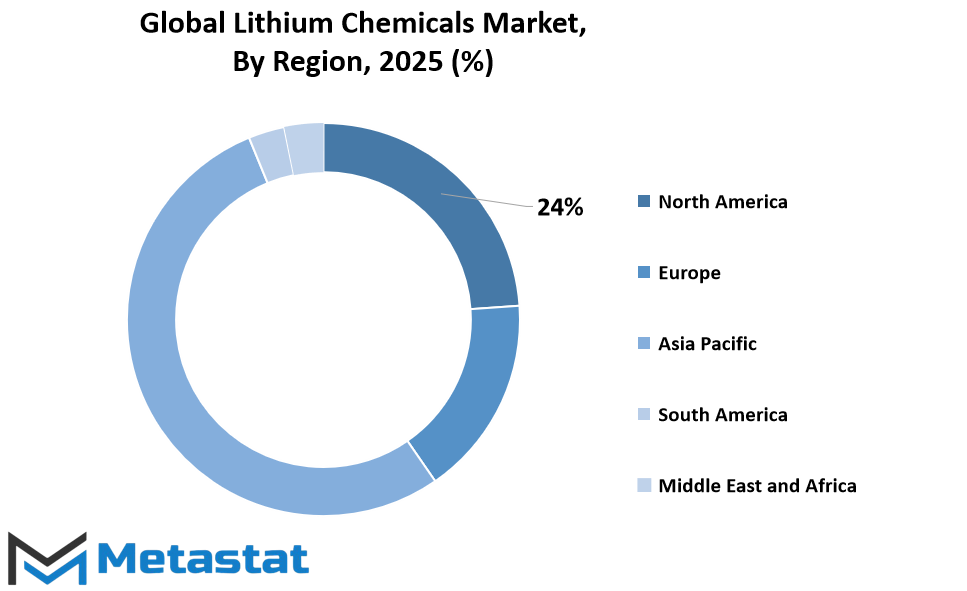
COMPETITIVE PLAYERS
The future of the global lithium chemicals market is likely to be shaped by the strategies and innovations of several major companies that have already established a strong foothold in this industry. As demand for lithium chemicals continues to grow, largely driven by advancements in battery technology and the shift towards electric vehicles, these companies will play a key role in how the market develops over the next decade. Companies like Albemarle Corporation, SQM, Tianqi Lithium Corporation, and Lithium Americas Corp are expected to focus heavily on expanding their production capacities to keep up with increasing global needs. They are also likely to invest more in research and development to improve the efficiency of lithium extraction and refining, aiming to meet both environmental standards and the growing expectations of manufacturers who rely on lithium-based products.
At the same time, other companies such as Merck KGaA, Piedmont Lithium Inc., and Neometals Ltd will continue to bring in new ideas and methods to strengthen their positions in the market. These organizations understand that the future will not only demand higher volumes of lithium chemicals but also more sustainable and cost-effective solutions. This is pushing them to explore cleaner technologies and partnerships that can help reduce their environmental impact while maintaining profitability. There is also a noticeable trend among these players towards securing stable supply chains by forming alliances or acquiring stakes in mining operations, especially in regions rich in lithium reserves.
Smaller but significant contributors like ProChem, Inc., Mody Chemi-Pharma Limited, and POWDER PACK CHEM will likely focus on carving out specialized niches within the industry. They may target specific customer needs or offer tailored solutions that larger corporations overlook. This diversity in business strategies helps the entire industry remain dynamic and flexible, providing room for growth in areas beyond just battery production, such as pharmaceuticals and industrial applications.
As competition intensifies, companies like Kanto Chemical Co. Inc., Kishida Chemical Co.,Ltd., and Shanghai Liangren Chemical Co., Ltd. will need to maintain high standards of quality and customer service while staying alert to shifts in global demand. The future landscape of Global Lithium Chemicals will likely see increased collaboration between these established players and emerging companies like JIGCHEM UNIVERSAL and Axiom Corporation. This will encourage innovation and drive the market forward. In this way, the future of the global lithium chemicals market appears to be one where competition fosters advancement, and companies work not just to succeed individually but to shape the industry in ways that benefit the broader world.
Lithium Chemicals Market Key Segments:
By Product Type
- Lithium Carbonate
- Lithium Hydroxide
- Lithium Chloride
- Lithium Metal
- Other
By Application
- Batteries
- Glass and Ceramics
- Lubricants and Greases
- Air Treatment
- Other
By End-Use Industry
- Automotive
- Electronics
- Aerospace
- Energy and Utilities
- Pharmaceuticals
- Other
Key Global Lithium Chemicals Industry Players
- Albemarle Corporation
- SQM (Sociedad Química y Minera de Chile)
- Merck KGaA
- Tianqi Lithium Corporation
- Lithium Americas Corp
- ProChem, Inc.
- Mody Chemi-Pharma Limited
- Piedmont Lithium Inc.
- SICHUAN BRIVO LITHIUM MATERIALS CO., LTD.
- Neometals Ltd
- LevertonHELM Limited.
- Kanto Chemical Co. Inc.
- Kishida Chemical Co.,Ltd.
- Shanghai Liangren Chemical Co., Ltd.
- POWDER PACK CHEM
- Nippon Chemical Industrial CO., LTD
- JIGCHEM UNIVERSAL
- Axiom Corporation
WHAT REPORT PROVIDES
- Full in-depth analysis of the parent Industry
- Important changes in market and its dynamics
- Segmentation details of the market
- Former, on-going, and projected market analysis in terms of volume and value
- Assessment of niche industry developments
- Market share analysis
- Key strategies of major players
- Emerging segments and regional growth potential



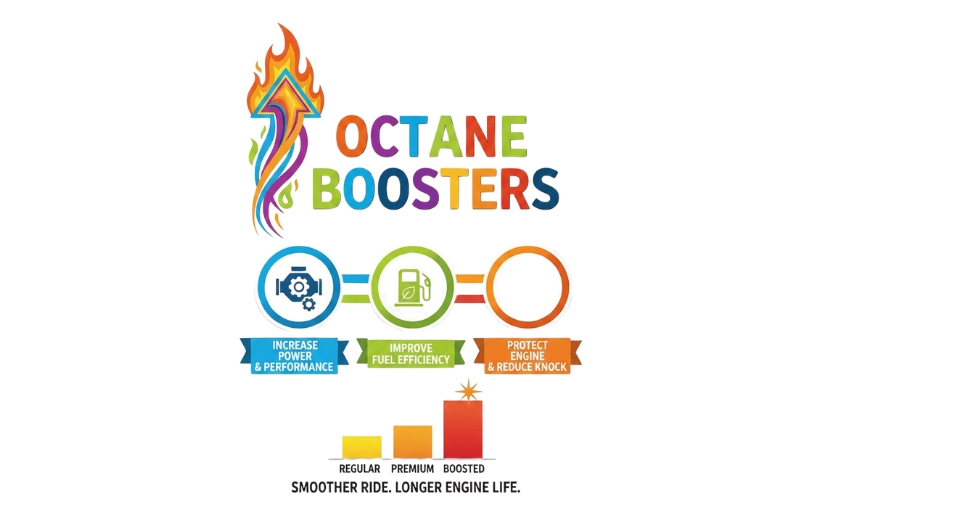
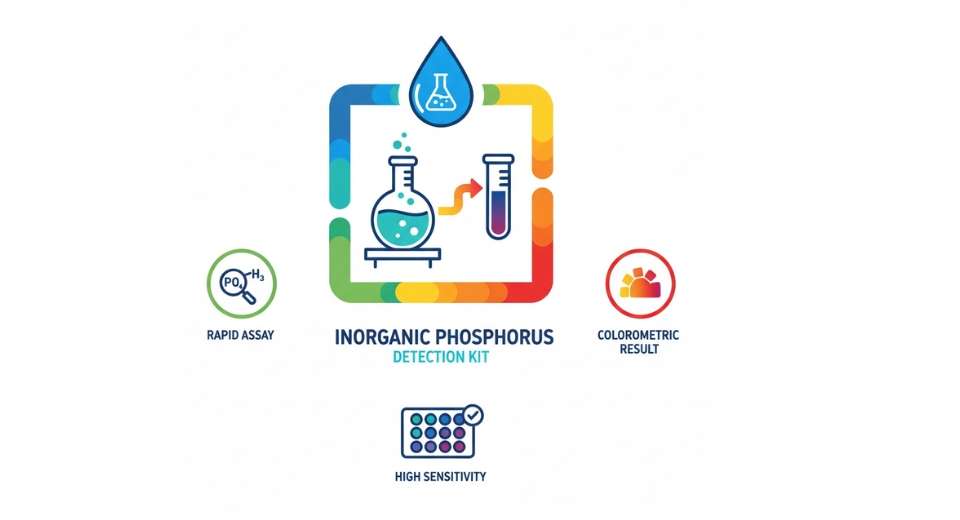
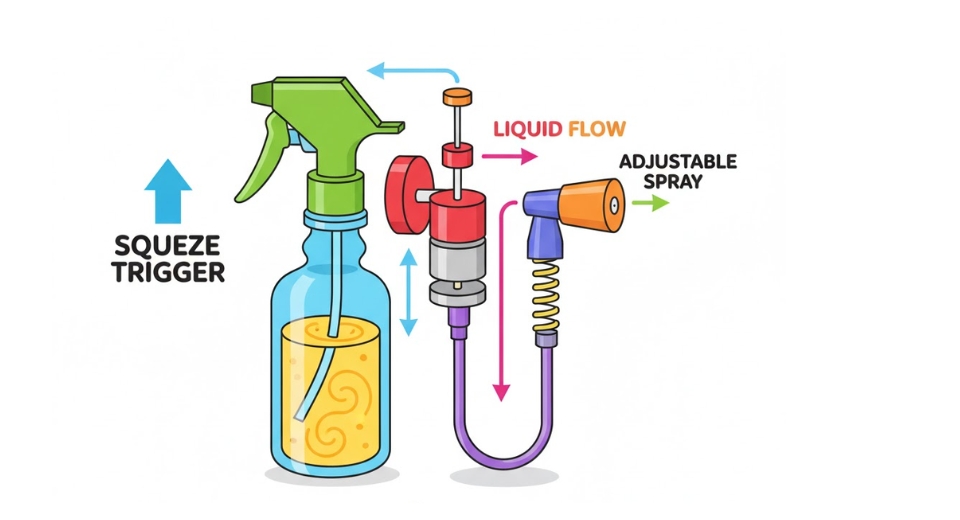
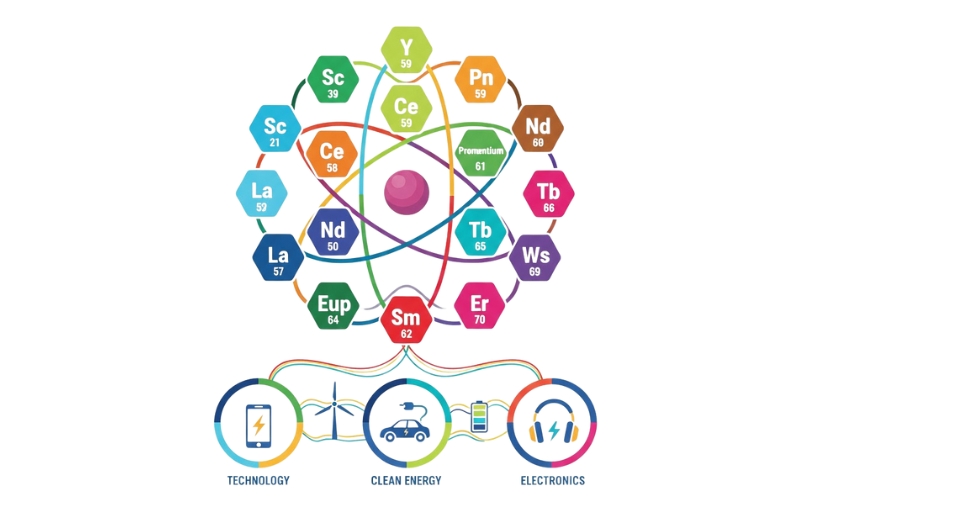

 US: +1 3023308252
US: +1 3023308252






